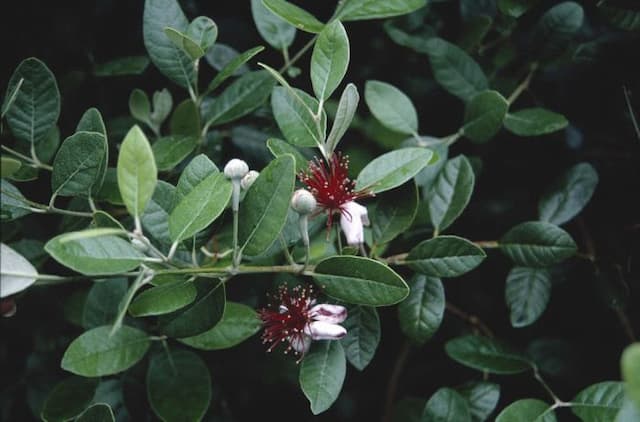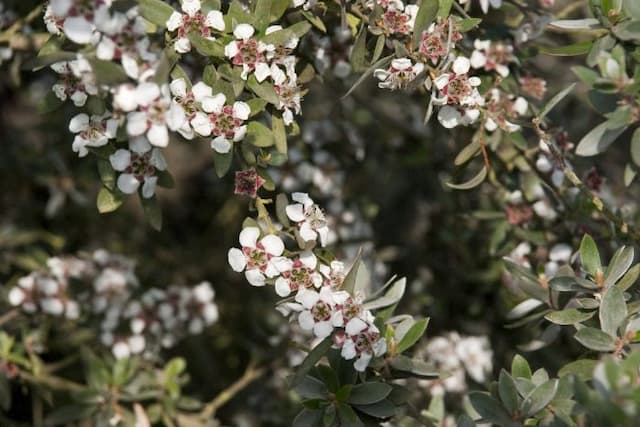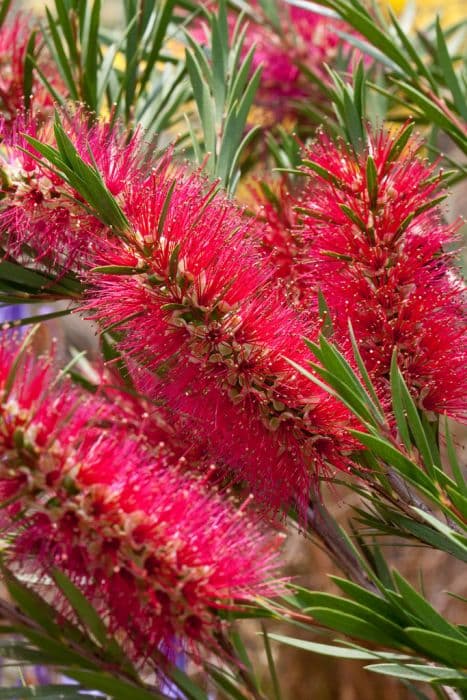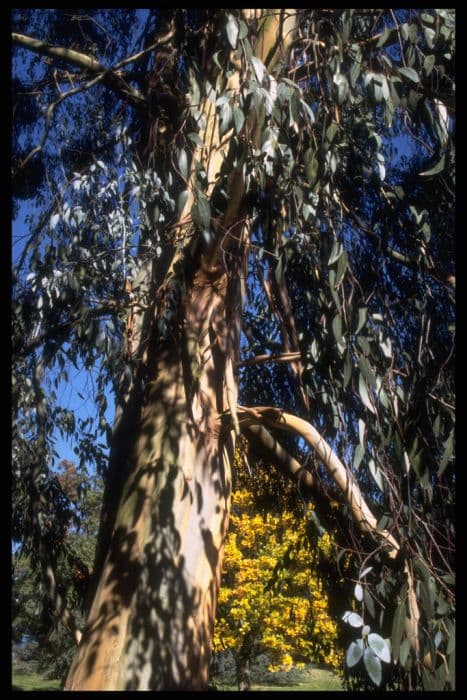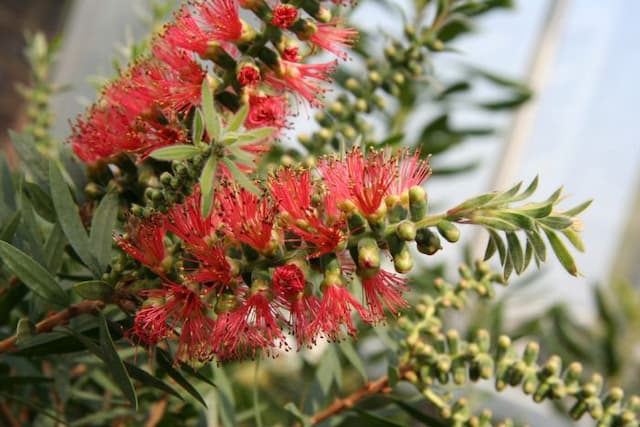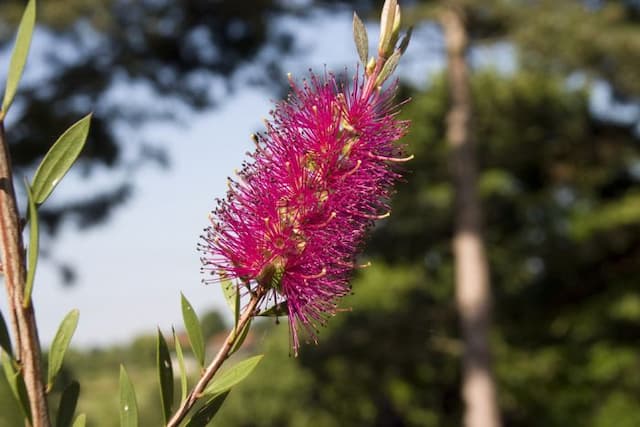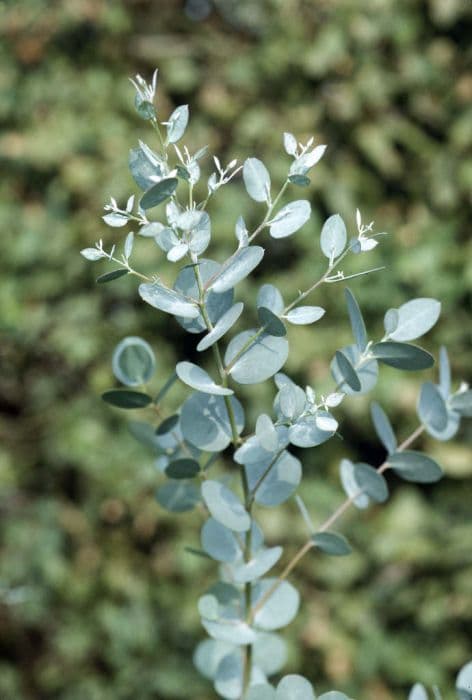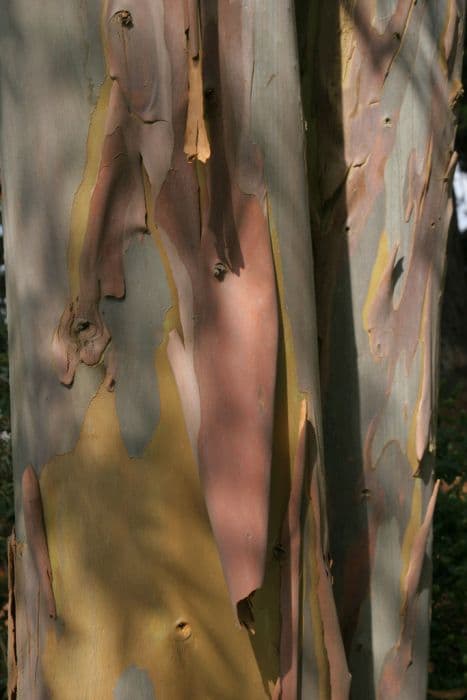Myrtle Myrtus communis

ABOUT
Myrtus communis, commonly known as common myrtle, is an appealing evergreen shrub with a dense and bushy appearance. It possesses glossy, dark green leaves that are small, ovate to lanceolate in shape, and filled with oil glands that release a fragrant aroma when crushed. The plant blooms in the summer, bearing an abundance of beautiful white flowers. These blossoms are star-shaped and consist of five petals that surround a bundle of prominent, fluffy yellow stamens, creating a striking contrast against the deep green foliage. Following the flowering period, the common myrtle produces purplish-black berries, which are small and round, and contain several seeds. Overall, common myrtle is prized for its decorative and aromatic qualities, embodying a classic Mediterranean aesthetic.
About this plant
 Names
NamesFamily
Myrtaceae
Synonyms
Common Myrtle, True Myrtle, Myrtle
Common names
Myrtus acuta, Myrtus baetica, Myrtus belgica, Myrtus communis f. variegata, Myrtus italica, Myrtus media, Myrtus microphylla, Myrtus minor, Myrtus parvifolia, Myrtus pimenta, Myrtus romana, Myrtus tarentina, Myrtus tomentosa
 Toxicity
ToxicityTo humans
The common myrtle is generally considered non-toxic to humans. However, it's always advisable to be cautious as individual reactions can vary, and consumption in large quantities may lead to gastrointestinal disturbance or other reactions in sensitive individuals.
To pets
The common myrtle is generally considered non-toxic to pets as well. As with humans, it's still best to prevent pets from ingesting plants as individual animals may have different sensitivities, and overconsumption could result in stomach upset or other issues.
 Characteristics
CharacteristicsLife cycle
Perennials
Foliage type
Evergreen
Color of leaves
Green
Flower color
White
Height
4-6 feet (1.2-1.8 meters)
Spread
4-6 feet (1.2-1.8 meters)
Plant type
Shrub
Hardiness zones
8-11
Native area
Mediterranean
Benefits
 General Benefits
General Benefits- Culinary Uses: Myrtle (Myrtus communis) berries and leaves add unique flavors to cuisine, particularly in Mediterranean dishes.
- Aromatic Properties: Myrtle has a pleasant, fragrant smell that makes it popular for perfumes and aromatic oils.
- Ornamental Plant: With its evergreen foliage and white flowers, myrtle is widely used for ornamental purposes in gardens and landscapes.
- Habitat for Wildlife: Myrtle provides a habitat and food source for various wildlife species, including birds and insects.
- Cultural Significance: Myrtle has historical and symbolic importance in many cultures, and is often used in traditions, ceremonies, and as a symbol of love and peace.
- Drought Tolerance: Myrtle is a hardy plant that is capable of withstanding periods of drought, making it suitable for xeriscaping and water-efficient gardens.
- Easy to Propagate: The plant can be easily propagated from cuttings, allowing gardeners to share and spread the plant with friends and family.
 Medical Properties
Medical Properties- Antiseptic: Myrtus communis essential oil has been used for its antiseptic properties, helping to clean wounds and prevent infections.
- Antioxidant: The leaves and berries contain compounds with antioxidant activity that help in protecting the body's cells from damage caused by free radicals.
- Anti-inflammatory: Myrtle possesses anti-inflammatory properties which can aid in reducing inflammation in various parts of the body.
- Expectorant: The plant has been traditionally used to relieve respiratory conditions by helping to expel phlegm from the lungs.
- Astringent: It has astringent properties that can help in toning the skin and mucous membranes, and in healing minor cuts or abrasions.
- Antidiabetic: Some studies have indicated that myrtle might have a potential use in lowering blood sugar levels, though this application requires more research.
- Antimicrobial: Myrtus communis extracts have shown antimicrobial activity against a range of microorganisms.
- Anti-ulcer: The plant has been used in traditional medicine to treat ulcers, suggesting potential gastroprotective effects.
- Diuretic: Myrtle has been used to stimulate urination, thereby possibly aiding in the removal of excess salts and water from the body.
- Antispasmodic: It has been used to relieve muscle spasms and cramps.
- Anticancer: There is some preliminary research suggesting that the compounds in myrtle might have anticancer properties. However, this potential use is still under investigation and is not confirmed for clinical recommendations.
- Hepatoprotective: Some studies suggest that Myrtus communis may offer protection to the liver from certain toxins, though this is not yet medically established.
 Air-purifying Qualities
Air-purifying QualitiesThis plant is not specifically known for air purifying qualities.
 Other Uses
Other Uses- Myrtle is historically used in wedding ceremonies; its branches and leaves are woven into bridal crowns to symbolize love and immortality.
- In landscaping, Myrtus communis can be trimmed into topiary shapes for decorative purposes in gardens and parks.
- The wood of Myrtus communis is valued for its pleasant fragrance and is used in turning and carving to create small decorative objects.
- The dried berries of myrtle can be used as a spice, similar to juniper berries, adding a peppery flavor to Mediterranean cuisine.
- A natural dye can be obtained from the leaves and branches of myrtle, typically resulting in shades of yellow or tan.
- The essential oil from Myrtus communis has been used in perfumery as a fragrant additive in various cosmetics and scented products.
- As a symbolic plant, myrtle has traditional uses in various cultures, such as being a plant of peace and justice in ancient times.
- In bonsai culture, myrtle is trained into miniature tree forms for aesthetic display and contemplative gardening.
- Myrtle foliage is sometimes used in the floral industry as a long-lasting green addition to bouquets and floral arrangements.
- Folklore traditions often utilize myrtle branches to ward off evil spirits, and it is associated with a number of superstitions and rituals.
Interesting Facts
 Feng Shui
Feng ShuiThe Myrtle is not used in Feng Shui practice.
 Zodiac Sign Compitability
Zodiac Sign CompitabilityThe Myrtle is not used in astrology practice.
 Plant Symbolism
Plant Symbolism- Love: Myrtle, as it is commonly known, has long been associated with love and is often included in wedding bouquets and ceremonies, symbolizing the loving union of marriage.
- Fertility: Because myrtle thrives and can spread easily, it is frequently seen as a symbol of fertility and abundance.
- Peace: The plant is also connected to peace, with its presence and scent in a garden believed to bring tranquility.
- Immortality: Myrtle's evergreen nature leads to its association with immortality and the eternal aspect of the human soul.
- Chastity: In historical texts and tradition, myrtle has been a symbol of chastity and was often associated with goddesses who represented purity.
- Beauty: The plant's delicate white flowers and attractive form contribute to its symbolism of beauty and youthfulness.
 Water
WaterMyrtle, commonly known as Myrtus communis, prefers consistent moisture but does not like to be waterlogged. During the growing season, it's generally recommended to water myrtle once a week with about 1 to 1.5 gallons of water, depending on the size of the plant and the climatic conditions. Always check the soil moisture before watering; the top inch should be dry to the touch but the soil below should remain slightly moist. In the fall and winter, reduce watering to every other week or when the soil is dry to a depth of two inches.
 Light
LightMyrtle thrives in full sun to partial shade. The best light conditions for Myrtle are in a spot where the plant can receive at least 6 to 8 hours of direct sunlight per day. If growing indoors, place it near a south-facing window for optimal light exposure.
 Temperature
TemperatureMyrtle is comfortable in a range of temperatures and can tolerate a minimum of around 30 degrees Fahrenheit, making it resistant to light frosts. The ideal temperature for this plant ranges from 60 to 75 degrees Fahrenheit. However, it should not be exposed to temperatures over 80 degrees Fahrenheit for prolonged periods.
 Pruning
PruningPruning is important for Myrtle to maintain its shape and encourage bushier growth. It is best to prune Myrtle in late winter or early spring before new growth begins. Pruning can be done once a year or every other year, depending on the desired size and shape of the plant.
 Cleaning
CleaningAs needed
 Soil
SoilThe common myrtle (Myrtus communis) thrives in well-draining soil rich in organic matter with a pH range of 5.5 to 7.5. A mix of two parts peat moss or coco coir, one part perlite, and one part compost creates an ideal environment for root growth and health.
 Repotting
RepottingCommon myrtles should be repotted every two to three years to prevent root bounding and to replenish soil nutrients, ideally during the spring.
 Humidity & Misting
Humidity & MistingMyrtus communis, or common myrtle, benefits from moderate to high humidity levels, around 50-60%, but can tolerate lower humidity if necessary.
 Suitable locations
Suitable locationsIndoor
Place common myrtle in bright, indirect light, and monitor humidity levels.
Outdoor
In full sun to partial shade, common myrtle requires protection from frost.
Hardiness zone
8-11 USDA
 Life cycle
Life cycleMyrtus communis, commonly known as common myrtle, begins its life cycle as a seed, which germinates in moist, well-drained soil under full sun to partial shade. Seedlings emerge and develop into young plants with lustrous green leaves; they benefit from occasional pruning to encourage bushy growth. As the plant matures, it produces fragrant white flowers during the summer, which are pollinated by insects, leading to the formation of purplish-black berries. These berries can then be dispersed by birds or other animals, which allows for the spread of the seeds they contain, resulting in the establishment of new plants. Common myrtle can also be propagated through semi-hardwood cuttings taken in summer; these cuttings root relatively easily and can form new plants. Over time, with proper care, common myrtle can grow into a dense, rounded shrub that can live for many years.
 Propogation
PropogationPropogation time
Spring-Early Summer
The common myrtle, Myrtus communis, is often propagated by semi-hardwood cuttings taken in the late summer. For this method, you would cut a 4 to 6-inch (10 to 15 cm) length of stem from the current year’s growth, making sure that each cutting has several leaves. The lower leaves are stripped off, and the cut end is often treated with rooting hormone to encourage root development. The cuttings are then placed in a well-draining potting mix and kept in a warm, humid environment until roots develop, which typically takes several weeks. Maintaining a consistent moisture level in the potting mix is crucial, and cuttings should be kept out of direct sunlight to prevent them from drying out before they have a chance to root.
